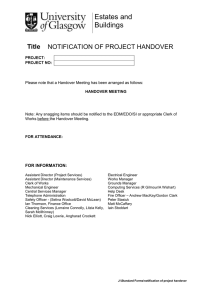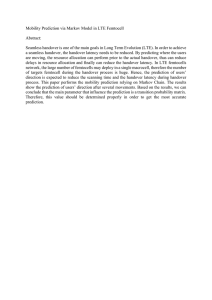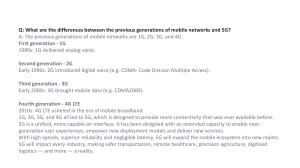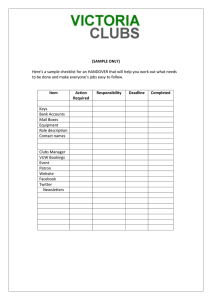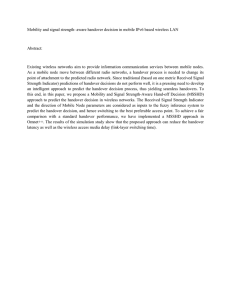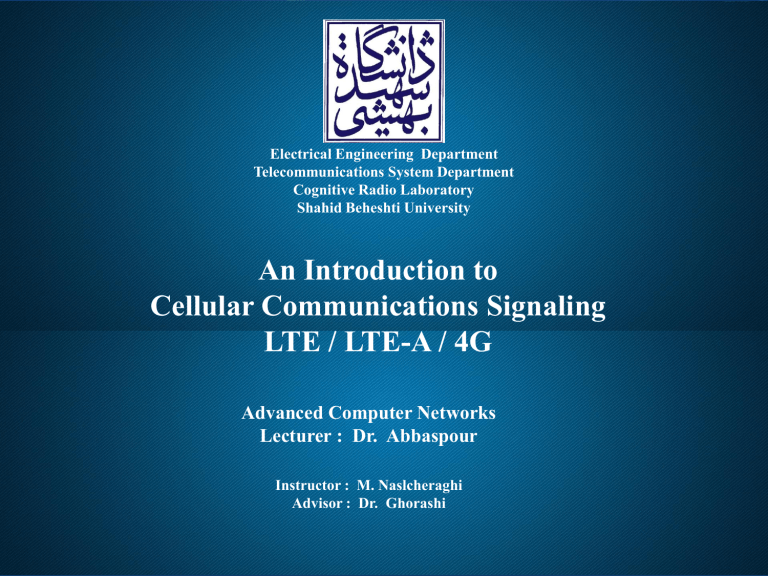
Electrical Engineering Department Telecommunications System Department Cognitive Radio Laboratory Shahid Beheshti University An Introduction to Cellular Communications Signaling LTE / LTE-A / 4G Advanced Computer Networks Lecturer : Dr. Abbaspour Instructor : M. Naslcheraghi Advisor : Dr. Ghorashi Contents 1 LTE Architecture 2 LTE Physical Layer Overview 3 OFDMA Modulation 4 Hand-over Procedures 5 Conclusions And Research Aspects LTE Architecture EVOLVED NODE B (ENB) FUNCTIONS • Radio resource management: radio bearer control, radio admission control, connection mobility control, uplink/downlink scheduling • IP header compression and ciphering of user data stream • Mobility management entity (MME) selection • Forwarding uplink data to serving gateway • Paging • Scheduling and transmission of broadcast information, originated from the mobility management entity (MME) or operations and maintenance (O&M) • Measurement and measurement reporting configuration for mobility and scheduling • Scheduling and transmission of Earthquake and Tsunami Warning System (ETWS) messages, originated from the MME Mobility Management Entity (MME) • Non-Access Stratum (NAS) signaling (attachment, bearer setup/deletion) • NAS signaling security • Signaling for mobility between 3GPP access networks (S3) • Idle mode user equipment reachability • Tracking Area list management • PDN gateway and serving gateway selection • MME selection for handoffs with MME change • Roaming - S6a to home subscriber server (HSS) • Authentication • Bearer management functions including dedicated bearer establishment • Support for Earthquake and Tsunami Warning System (ETWS) message transmission SERVING GATEWAY (S-GW) • Local mobility anchor for inter-evolved Node B (eNB) handover • Mobility anchor for inter-third-generation partnership project (3GPP) mobility • Evolved UMTS Terrestrial Radio Access Network (E-UTRAN) idle-mode downlink packet buffering and initiation of network triggered service request procedure • Lawful intercept • Packet routing/forwarding • Transport level packet marking (uplinking and downlinking) • Accounting on user and Quality of Service (QoS) class identifier granularity for inter-operator charging • Uplink and downlink charging per user equipment, packet data node (PDN), and QoS class identifier (for roaming with home routed traffic) HOME SUBSCRIBER SERVER (HSS) • Storage of subscriber data • Enhanced Presence Service (EPS) QoS subscriber profile • Roaming restrictions list • Accessible Access Point Names (APNs) • Address of current serving mobility management entity (MME) • Current Tracking Area (TA) of user equipment (UE) • Authentication vectors and security keys per UE • Provide subscriber policies using Sp interface to PCRF PDN GATEWAY (P-GW) • PDN gateway • Per-user packet filtering • Lawful intercept • User equipment (UE) IP address allocation • Transport level packet marking for downlinking • Uplink/downlink service level charging, gating, and rate enforcement • Downlink rate enforcement based on aggregate maximum bit rate (AMBR) LTE Physical Layer Overview LTE Requirements Peak bit (not data) rate – 100 Mbps DL/ 50 Mbps UL within 20 MHz bandwidth (i.e., SISO) Up to 200 active users in a cell (5 MHz) Less than 5 ms user-plane latency condition (i.e., single user with single data stream Mobility – Optimized for 0 ~ 15 km/h – 15 ~ 120 km/h supported with high performance – Supported up to 350 km/h or even up to 500 km/h Enhanced multimedia broadcast multicast service (E-MBMS) Spectrum flexibility: 1.25 ~ 20 MHz Enhanced support for end-to-end QoS & QoE LTE Physical Layer Overview LTE Enabling Technologies OFDM (Orthogonal Frequency Division Multiplexing) for Down Link • Frequency domain equalization • SC-FDMA (Single Carrier FDMA) for Up Link Utilizes single carrier modulation and orthogonal frequency Multiplexing using DFT-spreading in the transmitter and frequency domain equalization in the receiver A salient advantage of SC-FDMA over OFDM/OFDMA is low PAPR. Efficient transmitter and improved cell-edge performance MIMO (Multi-Input Multi-Output) • e.g., Open loop, Close loop, Diversity, Spatial multiplexing Multicarrier channel-dependent resource scheduling Fractional frequency reuse Active interference avoidance and coordination LTE Physical Layer Overview LTE Key Features Multiple access scheme • DL: OFDMA with CP (Cyclic Prefix) • UL: Single Carrier FDMA (SC-FDMA) with CP Adaptive modulation and coding • DL/UL modulations: QPSK, 16QAM, and 64QAM Convolutional code and Rel-6 turbo code Advanced MIMO spatial multiplexing techniques • (2 or 4)x(2 or 4) downlink and uplink supported • Multi-user MIMO also supported Support for both FDD and TDD H-ARQ, mobility support, rate control, security, and etc... Orthogonal Frequency Division Multiple Access Orthogonal Frequency Division Multiple Access Orthogonal Frequency Division Multiple Access Some Mathematics Decisions That Should be solved in One RB One typical resource allocation optimization problem…. One typical Spectrum Sharing optimization problem…. Some Mathematics Decisions That Should be solved in One RB Another example of calculations of interference at subcarrier Correlation between signals…… Orthogonal Frequency Division Multiple Access OFDMA Time-Freq Multiplexing LTE Physical Layer Overview Physical Channel Structure Downlink – PBCH: Transmit Broadcast channel – PCFICH: Indicate PDCCH symbol – PDCCH: Assign PDSCH/PUSCH – PHICH: Indicate HARQ-ACK for UL – PDSCH: Transmit Data – PMCH: Transmit Multicast channel – Synchronization Signal: UE synchronization LTE Physical Layer Overview Physical Channel Structure Uplink – PUCCH: Transmit ACK/NACK, CQI, SR – PUSCH: Transmit Data – PRACH: Transmit Random Access Preamble – SRS: For UL CQI measurement LTE Physical Layer Overview • Basic Procedure Between eNodeB and UE The procedure for synchronization and obtaining of system Info MIB : system frame number, DL bandwidth, PHICH information are included SIB : Cell specific information are included for system operation except MIB information SIB1: cell access configuration, frequency band indicator, scheduling information for system and other SIBs and systemInfoValueTag SIB2: radio configuration information are included (PUCCH, PUSCH, SRS etc) GTP and One Handover Procedure in Detail GTP Versions and GPRS Interfaces Overview Main Purpose: The General Packet Radio Service (GPRS) tunneling protocol (GTP) is used to tunnel GTP packets through 3G and 4G networks. A Mobile Next Broadband Gateway configured as a gateway GPRS support node (GGSN), Packet Data Network Gateway (P-GW), or GGSN/P-GW automatically selects the appropriate GTP version based on the capabilities of the serving GPRS support node (SGSN) or Serving Gateway (S-GW) to which it is connected. GTP Versions and GPRS Interfaces Overview GTP Versions and GPRS Interfaces Overview GTP-C GTP-C is used within the GPRS core network for signaling between gateway GPRS support nodes (GGSN) and serving GPRS support nodes (SGSN). This allows the SGSN to activate a session on a user's behalf (PDP context activation), to deactivate the same session, to adjust quality of service parameters, or to update a session for a subscriber who has just arrived from another SGSN. Why is GTP used in LTE? • It provides mobility. When UE is mobile, the IP address remains same and packets are still forwarded since tunneling is provided between PGW and eNB via SGW • Multiple tunnels (bearers) can be used by same UE to obtain different network QoS • Main IP remains hidden so it provides security as well • Creation, deletion and modification of tunnels in case of GTP-C GTP Interfaces in LTE In simple LTE network implementation, GTP-v2 is used on S5 and S11 interfaces and GTPv1 is used on S1-U, S5, X2-U interfaces (as shown below). In inter-RAT and inter PLMN connectivity, S3, S4, S8, S10, S12 and S16 interfaces also utilize GTP protocols: How GTP-U Works ? GTP-C Signaling Handover Procedure In LTE there are three types of handovers: • Intra-LTE: Handover happens within the current LTE nodes (intra-MME and Intra-SGW) • Inter-LTE: Handover happens toward the other LTE nodes (inter-MME and Inter-SGW) • Inter-RAT: Handover between different radio technology networks, for example GSM/UMTS and UMTS Handover Procedure Handover procedure in LTE can be divided into three phases: Handover preparation handover execution handover completion LTE Physical Layer Overview Handover Measurements Handover decisions based on the downlink channel measurements which consist of : 1. Reference Signal Received Power (RSRP) 2. Reference Signal Received Quality (RSRQ) LTE Physical Layer Overview RSRP important item UE has to measure for cell selection, reselection and handover. one downlink radio frame. The red part is the resource elements in which reference signal is being transmitted. RSRP is the linear average of all the red part power. LTE Physical Layer Overview RSRP • UE usually measures RSRP or RSRQ based on the direction (RRC message) from the network and report the value. When it report this value, it does use the real RSRP value. • It sends a non-negative value ranging from 0 to 97 and each of these values are mapped to a specific range of real RSRP value as shown in the following table from. Intra-LTE (Intra-MME/SGW) Handover Using the S1 Interface Intra-LTE (Intra-MME/SGW) Handover Using the X2 Interface Inter-MME Handover Using the S1 Interface (Without Changing S-GW) LTE X2 Handover Sequence Diagram LTE Architecture LTE X2 Handover Sequence Diagram Source eNodeB Target eNodeB X2AP Handover Request • eNodeB decides to initiate an X2 handover based on: • UE reported RRC downlink signal quality measurements • Uplink signal quality measured at the eNodeB • eNodeB picks the target cell id for the handover. • X2 handover is initiated if and If the target cell is served by the same MME as the current cell • The message includes UE context information that identifies the UE on the S1AP interface. • Security parameters are also included in the message • Information about the radio bearers is included in the message. The per RAB information includes • QoS parameters • GTP Tunnel Information • The message also includes RRC context information LTE X2 Handover Sequence Diagram Target eNodeB Source eNodeB X2AP Handover Request Acknowledge • The target eNodeB receives performs admission control on receipt of the Handover Request. • The target eNodeB responds with X2AP Handover Request Acknowledge. • Information about the accepted RABs is included in the message. • The Uplink and Downlink GTP Tunnel information is included for each RAB. • The tunnel assignments are made at the target to transport traffic during the handover. • A Handover Command message sent via a transparent container. • The source eNodeB send this message to the UE. LTE X2 Handover Sequence Diagram Source eNodeB Target eNodeB X2AP SN Transfer Status • The source eNodeB now sends the SN Transfer Status • The following fields are present for each RAB • The uplink PDCP sequence number • Uplink Hyper Frame Number • The downlink PDCP sequence number • Downlink Hyper Frame Number • These fields are needed for continuing ciphering and integrity protection after the handover. LTE X2 Handover Sequence Diagram Target eNodeB MME S1AP Path Switch Request • The target eNodeB requests switching of the S1-U GTP tunnel towards the target eNodeB. • The MME identifies the UE with the “eNB to UE S1AP ID” • The message includes the new cell ID and the tracking area ID • Security capabilities of the target eNodeB are also included. LTE X2 Handover Sequence Diagram MME SGW Modify Bearer Request • The MME requests the SGW to switch the path to the target eNodeB. The S1-U TEID received from the target eNodeB is passed to the SGW. LTE X2 Handover Sequence Diagram SGW MME Modify Bearer Response • SGW updates the bearer and responds back LTE X2 Handover Sequence Diagram S1AP: MME Target eNodeB S1AP Path Switch Acknowledge • The target eNodeB requests switching of the S1-U GTP tunnel towards the target eNodeB. • The MME identifies the UE with the “eNB to UE S1AP ID” • The message includes the new cell id and the tracking area id • Security capabilities of the target eNodeB are also included. LTE X2 Handover Sequence Diagram Target eNodeB Source eNodeB X2AP UE Context Release • Sent when the target eNodeB has successfully completed the path switching and radio signaling for the handover. LTE X2 Handover Sequence Diagram UE-NAS MME-NAS Tracking Area Update Request MME-NAS UE-NAS Tracking Area Update Accept • Sent if the just completed • Sent if the just completed handover resulted in a Tracking handover resulted in a Tracking Area Update Area Update Conclusions and Research Aspects The main criteria for designing handovers are: Minimize the number of handover failures. Minimize the number of unnecessary handovers. Minimize the absolute number of initiated handovers. Minimize handover delay. Maximize the total time the user being connected to the best cell. Minimize the impact of handover on system and service performance. Thank You for Your Attention
